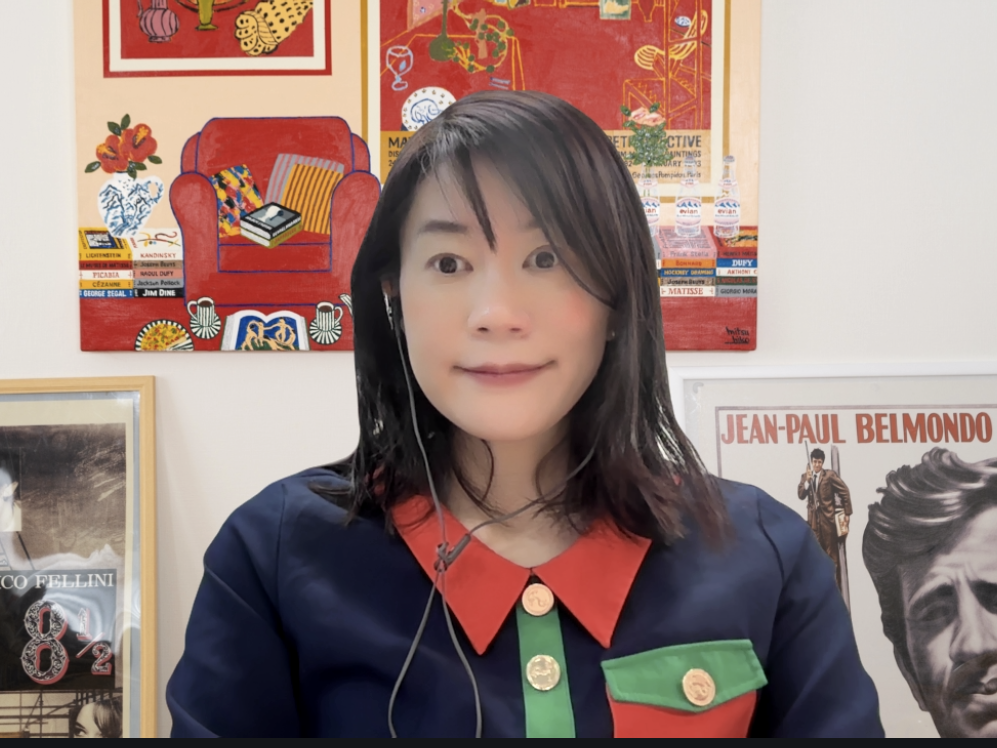Regardless of disability, age, gender, race, etc. A society in which all people can play an active role, regardless of disability, age, gender, race, etc. Kawasaki City’s “Kawasaki Para-Movement” – a movement to create a society where all people, regardless of disability, age, gender, race, or nationality, can thrive.
7/22/25
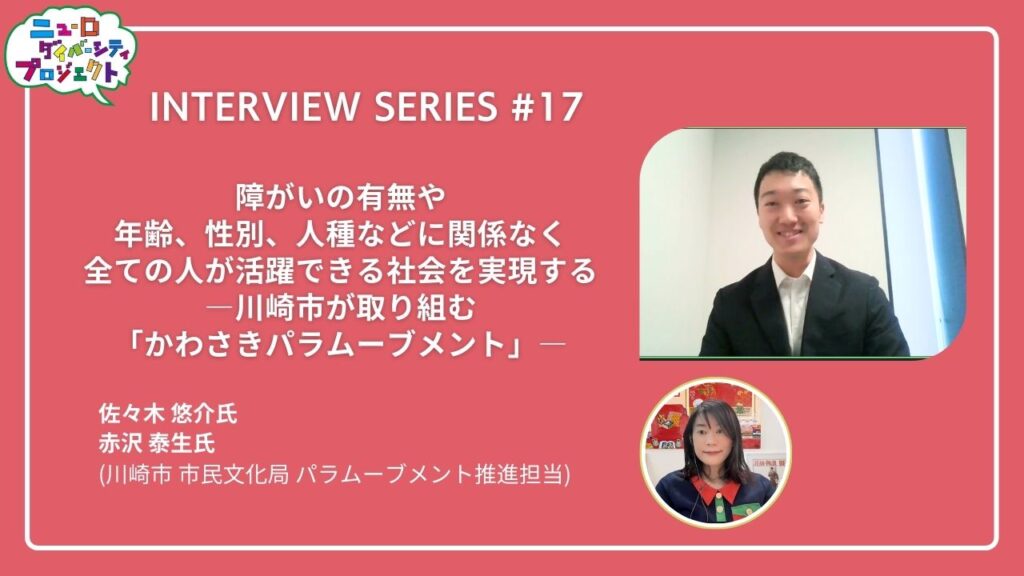
The Neurodiversity Project, sponsored byB Lab,aims to realize a society in which everyone is able to exercise their abilities in their own way, respecting the diversity of the brain and nervous system. In this Neurodiversity Project interview series, we will introduceKawasaki City’s efforts to realize a society in which everyone can play an active role regardless of disability, age, gender, or race.Ahead of other municipalities in Japan, the citylaunched the “Kawasaki Paramovement” in2016, aiming to create a mixed-minority society where both majorities and minorities can live together in harmony. Kawasaki City Civic and Cultural Affairs Bureau Mr. TaiseiAkazawa (▲Picture1▲)andMr. YusukeSasaki , in charge of promoting the Paramovement,were interviewed byB LabDirectorNanakoIshido (▲Picture10▲)about the background, specifics and future prospects of the initiative.
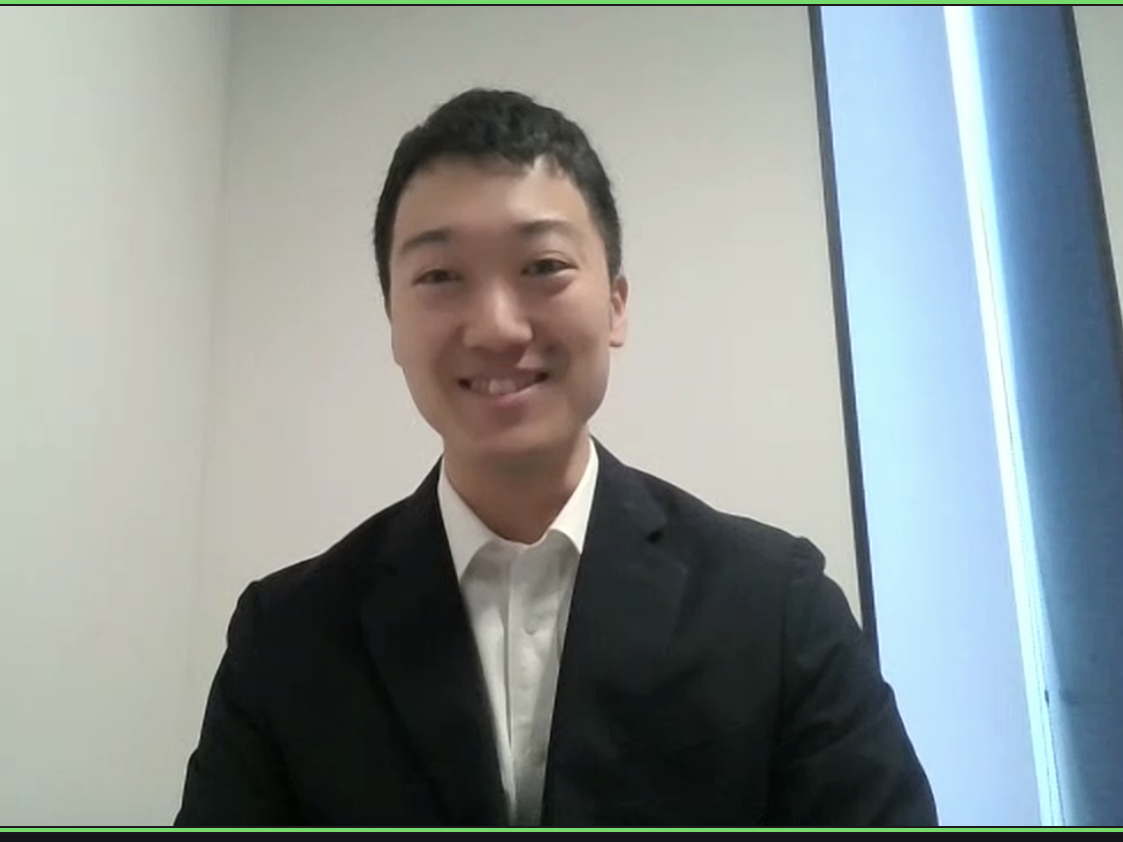
A community where everyone can achieve self-fulfillment in their own way
The government and citizens work together to create a community where everyone can achieve self-fulfillment in their own way.
Ishido: In 2016, the City of Kawasaki launched the “Kawasaki Para Movement” initiative, which focuses not only on visible disabilities but also on invisible issues that each individual has. Please tell us about this initiative, which can be considered a pioneering neurodiversity project.
Akazawa: The Kawasaki Para-Movement is a movement in which Kawasaki City and its citizens are working together to realize a society in which all people, regardless of disability, age, race, or sexual minority, can play an active role. The initiative was triggered by the Tokyo 2020 Olympic and Paralympic Games. With the two elements of diversity and social inclusion symbolized by the Paralympics as the foundation of its activities, Kawasaki is working to create a community where everyone, regardless of age or disability, can achieve self-fulfillment in their own way, not only in sports but also in other activities. (▲Photo 2▲)
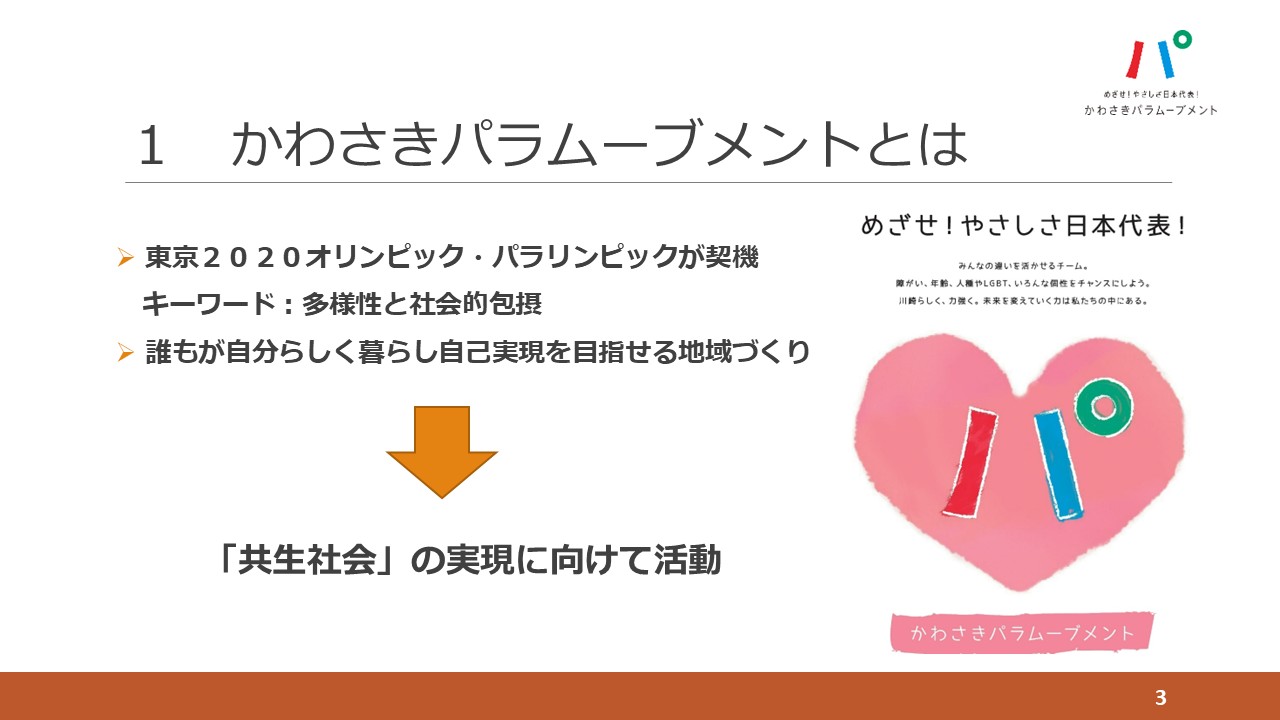
Aim! The slogan is “Representing Kindness in Japan! The slogan “Kawasaki City and its citizens are working together as one team to realize a symbiotic society.
Reference: Kawasaki Para Movement HP “About Kawasaki Para Movement
https://www.city.kawasaki.jp/2020olypara/page/0000084341.html
The goal of the Kawasaki Para-Movement is to create a “mixed society,” so to speak. (Photo 3)

Since everyone, regardless of society, disability, or age, aims for self-realization in their own way, we do not want a society where minorities (red circles) are gathered and segregated, but a society where the majority (white circles) and minorities are recognized as individuals and mixed into society, regardless of their disability or age.
The Kawasaki Para-Movement
Seven legacies to leave behind for the future
In order to achieve a mixed society, the City of Kawasaki has established seven legacies related to diversity and social inclusion. Legacy here has a general meaning of results to date, but it is more about goals for the future. We call them legacies in the sense of ‘what we will leave behind for the future. (Photo 4)
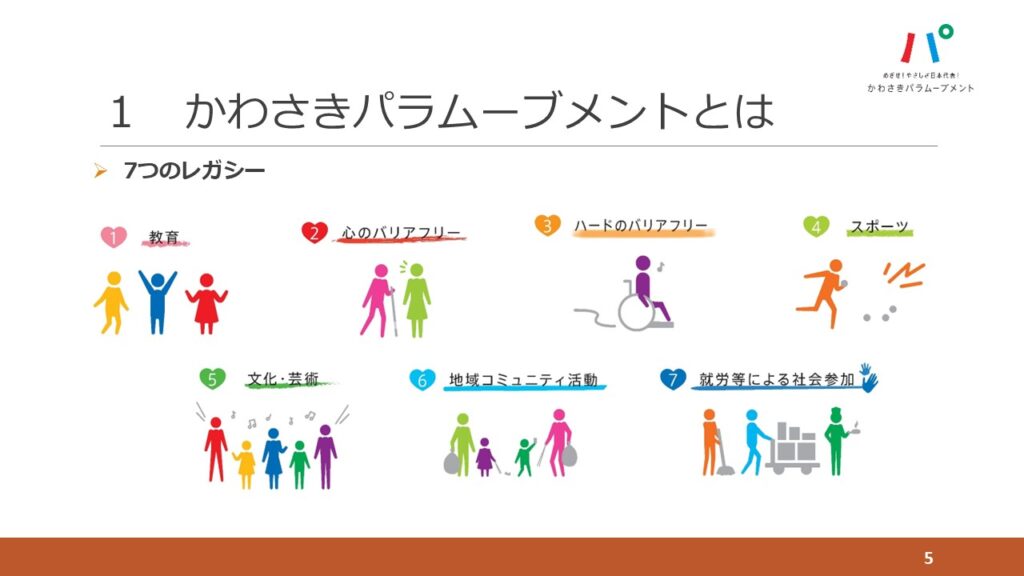
The seven legacies are based on the concept of the “Social Model of Disability. To understand this concept, it would be easier to understand if you imagine a situation in your daily life where a social minority is in trouble. For example, if a wheelchair user is unable to enter a certain store because there are stairs, the social model of disability considers that “the presence of stairs creates a disability in society. The social model of disability is rooted in the idea that society creates the disability, not the individual disability characteristic of physical disability. Based on this belief, we have established these seven legacies in an effort to eliminate physical and psychological barriers.
I will explain what we are doing in each of these legacies. First, Legacy 1 is education. We are promoting initiatives to help children, who will be responsible for the future, understand and act correctly toward social minorities, and we are holding exchange classes with para-athletes. In this initiative, students from municipal junior high schools and para-athletes invited from the outside play tag, scavenger hunts, and other games together, discussing and deciding how they can work together. This is an opportunity for each student to deepen his or her thinking toward the realization of a symbiotic society. (Photo 5)
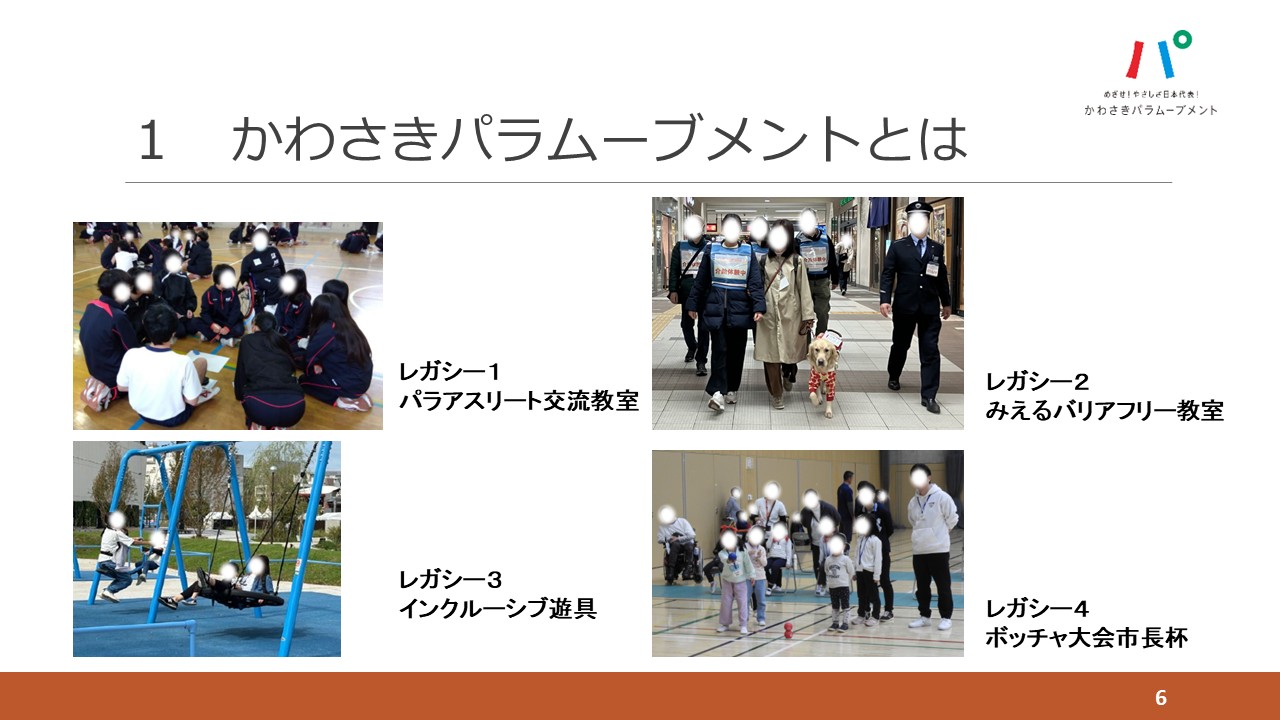
Legacy 2 is a barrier-free mind. Many people tend to unconsciously build walls against people with whom they rarely have the opportunity to interact. Therefore, Legacy 2 aims to encourage people to accept each other’s differences and act accordingly through interaction with a variety of people. At an event held in Musashi-Kosugi in the city, participants learned how to treat people with disabilities when they notice them in need while transferring on public transportation. Conducted in an open format, the event was able to communicate not only to the participants but also to those who did not take part in the program, practicing barrier-free mindedness and working toward the realization of a mixed society.
Legacy 3 is hardware barrier-free. Based on the social model of disability, the goal is to remove hardware barriers that impede mobility and activity when engaging in a variety of activities, including daily living and hobbies. One example of this approach is the installation of inclusive playground equipment. Swings are usually enjoyed in a seated position, but some children have difficulty maintaining this posture. The swings are designed for such children to enjoy, and because they are large, they can be played with adults.
Legacy 4 is a sport. It is an initiative to make sports accessible to everyone, regardless of disability or age. A typical example is the holding of a parasport boccia tournament and the Mayor’s Cup, named after the mayor of Kawasaki City.
Legacy 5 is cultural arts. Becoming familiar with the arts, such as painting and music, is a step toward self-expression and self-realization. Kawasaki City is promoting initiatives while making use of the abundant art facilities in the city. One example is the inclusive music project “Various Negroes,” in which participants with and without disabilities and of different ages can freely play music and feel connected to each other. (Photo 6)
Reference: Kawasaki Paramovement HP “About the Inclusive Music Project “Various Negroes””.
https://www.city.kawasaki.jp/2020olypara/page/0000152297.html

Legacy 6 is a local community activity. In order to promote sustainable community development even as the social structure changes in the future, such as declining birthrates, an aging population, and a shrinking population, we are promoting initiatives to enable diverse people to participate in the local community with the help of various businesses and organizations. One example is the “Kawasaki Wakamono Mirai Project. High school students living and attending school in the city come up with their own ideas of what they want to do, and with the support of university students and adults in the community, they work on their projects.
The last Legacy 7 is social participation through work. This is an initiative to enable people to participate in society through occupational and hobby activities, and those who experience work will work as ushers and cleaners at various events held in the city. This is an initiative to enable participants to enjoy work and feel a social connection through actual work. (Photo 6)
In cooperation with businesses, schools, citizens and the community
Quiet Hour” and “Barrier-Full Restaurants.”
The initiatives I have described so far are being promoted throughout the City of Kawasaki. The first is the “Quiet Hour” initiative. One is the “Quiet Hour” initiative, in which sound and light are restricted for a certain period of time at commercial facilities to create an environment that facilitates shopping for people with sensory sensitivity who are easily fatigued by external stimuli such as light and sound.
Participation in a project of the Japan Developmental Disabilities Network, a general incorporated association, in 2017 was the impetus for implementing Quiet Hour. As an initiative to realize Legacy 2 mental barrier-free and Legacy 3 hardware barrier-free, we implemented the program on a trial basis at the Aeon Style Shin-Yurigaoka store in 2019. Subsequently, we collaborated with universities and related organizations to create a support book based on the voices of the people involved.
The reason for creating the support book was to make the symptoms of developmental disabilities, which are difficult to recognize from the outside, widely known to the general public, and to provide a checklist that can be used to support businesses that support the Quiet Hour when they try to implement the program on their own. We have received requests from people who want to make Quiet Hour and sensory sensitivity known to the public to lend us their support books, and now Quiet Hour is held regularly at supermarkets and electronics retailers.
This Quiet Hour has spread beyond Kawasaki City, including Sagamihara City and Okinawa Prefecture, and we consider it to be one success story. After creating the support book, we actually visited a Tokyu Store in the city to see how it was doing. The store had reduced the number of lights to reduce stimulation by light, and cut background music in the store except for emergency broadcasts to reduce stimulation by sound, creating an environment where people with sensory sensitivity can easily shop. (▲Photo 7▲)
Reference: Kawasaki Paramovement “Support Book for Implementing Quiet Hour”.
https://www.city.kawasaki.jp/2020olypara/page/0000134874.html
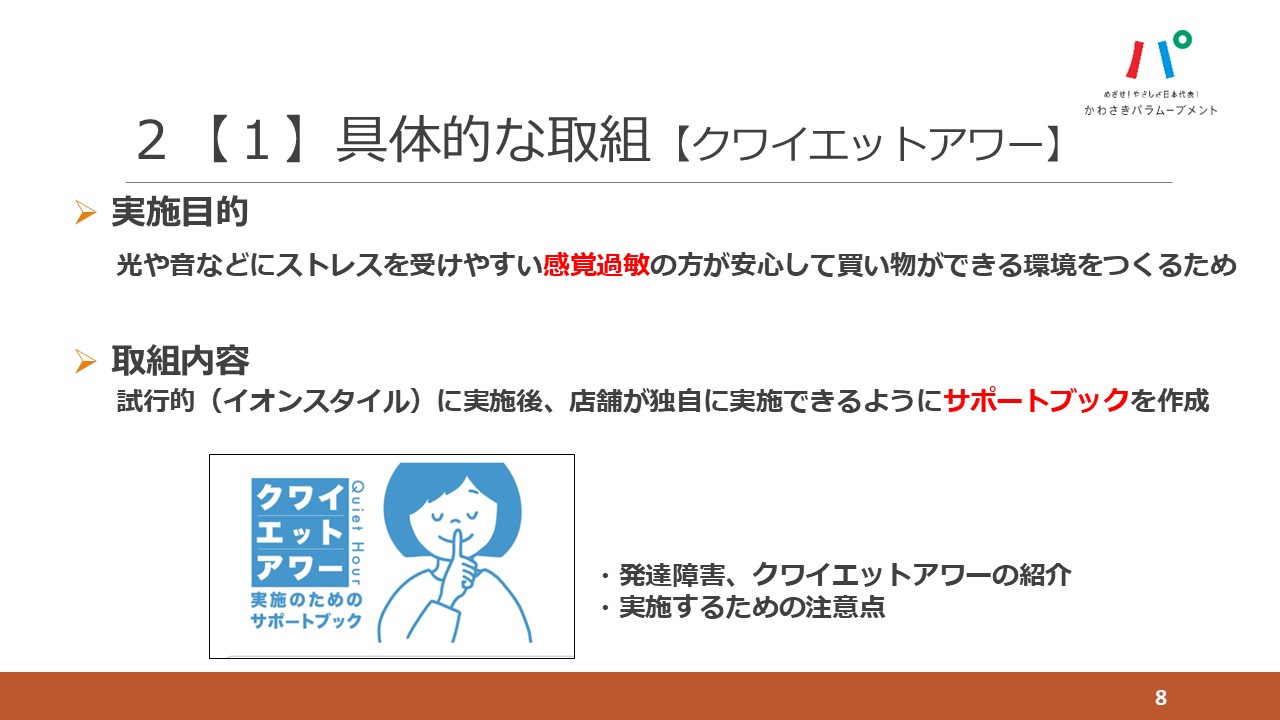
Next, I would like to introduce the “Barrier-Full Restaurant” initiative. This initiative is implemented together with the Japan CareFit Co-education Organization. The objective of this program is to encourage behavioral change after experiencing the program by asking the question, “What is a disability created by society and what is the norm?
Barrier-Free Restaurant” is a program open to the general public. The majority of the patrons in the restaurant are in wheelchairs, and this program allows patrons to experience a world in which “able-bodied people who are generally considered to have no disabilities are in fact disabled people” in reverse. Since the majority of visitors are wheelchair users, there are no chairs in the store, and the ceiling is lowered to accommodate wheelchair users. By placing able-bodied people in an environment with social barriers in a semi-forcible manner, the program aims to expose them to the idea of a social model of disability, which is at the core of the Paramovement, and to make them think about disability issues as their own personal matters. The program is widely held at commercial facilities, schools, local events, and other locations in Kawasaki City, with different targets.
In FY2024, a student-led Barrier Full Restaurant event was held at Kawasaki Municipal High School. Since the event was to be held at a cultural festival, the students were given five workshops in advance, and the students and visitors who had not taken the Barrier-Full Restaurant workshop at the festival were able to experience the restaurant as an unveiling. The low ceilings made visitors bend over to experience the Barrier-Full Restaurant, feeling a “barrier,” so to speak. (▲Photo 8▲)
Reference: Kawasaki Paramovement “2024 Barrier-Free Restaurant at Kawasaki Municipal High School’s Cultural Festival!
https://www.city.kawasaki.jp/2020olypara/page/0000169378.html
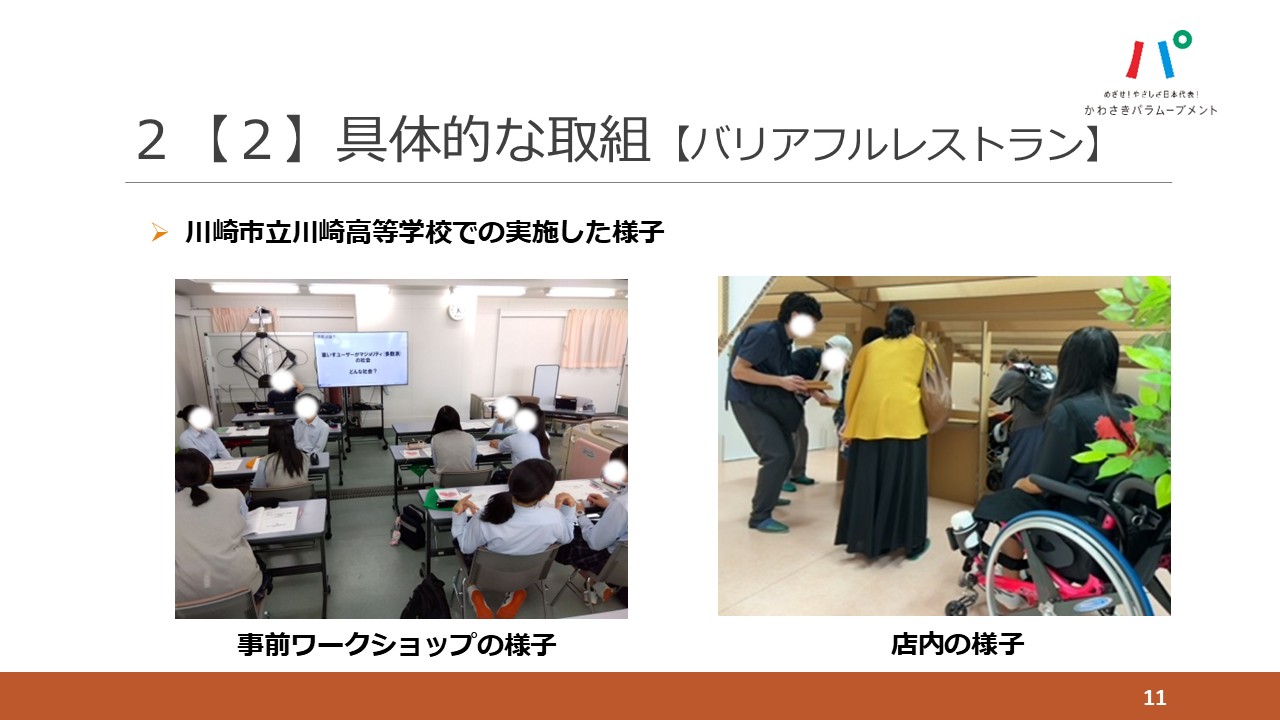
The Paramovement Promotion Office is promoting an initiative for city employees on the provision of reasonable accommodation. The purpose of this initiative is to ensure that all city employees understand the concept of reasonable accommodation and mental barrier free, so that they can provide the same administrative services to everyone, regardless of whether they have a disability or not. First, a basic policy on the provision of reasonable accommodation is established, and based on this policy, a support book for city employees is prepared and made public. (Photo 9)
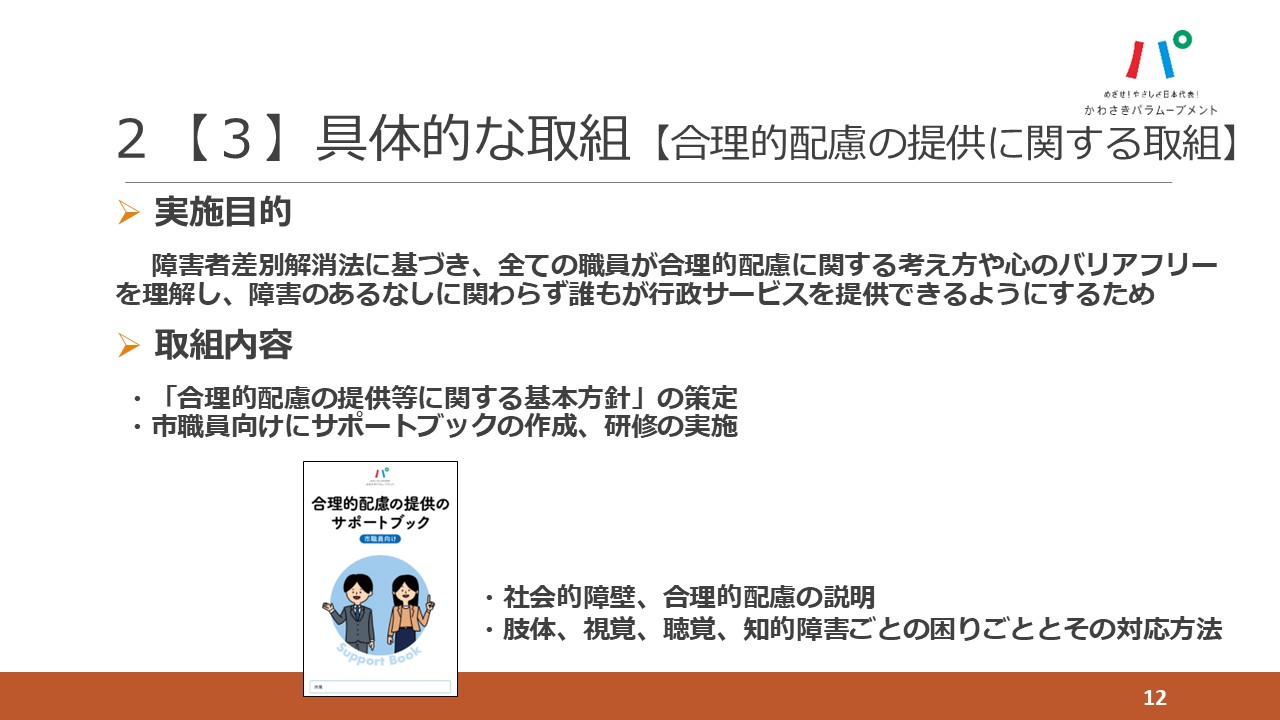
While utilizing this support book, we conduct training for both management and general staff. However, since it is assumed that knowledge alone may be biased, we actually invite people with disabilities from outside to give lectures to staff members, and we also provide hands-on experience in assisting visually impaired persons and others.
Although the changes are gradual
Behavioral changes are definitely starting to occur.
Ishido: Thank you very much. I again thought it was wonderful that you tackled the issue in a comprehensive manner. While recognition and awareness of visible disabilities are spreading, I think it is also significant that you have tackled invisible developmental disabilities and sensory hypersensitivity.
Did the Kawasaki Para-Movement project go off without a hitch with the government and the citizens of Kawasaki?
Akazawa: In terms of penetration of the social model, we are conducting an awareness survey. The degree of penetration is gradually spreading, but it is still only about 20%, and we believe that we need to continue publicizing the social model.
Ishido: You say that the penetration rate is 20% at this point, but since you started the initiative in 2016, have you seen a change in behavior among various stakeholders, such as government employees and citizens?
Akazawa: As an example, Kawasaki City Kawasaki High School, which worked on the “Barrier-Full Restaurant,” realized through this experience that “society creates disabilities,” and came up with the idea of putting stickers on city buses running in Kawasaki Ward and implemented it. I believe that the change in behavior was really gradual, but I believe that there was a change in behavior.
Ishido: I would be happy to see more and more cases of people voluntarily working on this issue. I feel that providing and continuing learning to think about inclusive environments, even if it takes time, will lead to the realization of an inclusive society.
I believe that Kawasaki City was probably the first commercial facility in Japan to introduce the Quiet Hour. I imagine there was some initial confusion on the part of the commercial facilities, but please tell us about the reaction at the time of the introduction and the effects afterwards.
For example, in the United Kingdom, Quiet Hour has been introduced in commercial facilities, and it has had the effect of increasing the number of customers who visit stores during that time, not only those with sensory sensitivity, which was considered to be the target of the program, and as a result, sales have also increased. I would like to know the reaction of such commercial facilities and the effects after the introduction.
Mr. Sasaki: On behalf of Akazawa, I, the other person in charge of promoting the “Quiet Hour,” would like to talk about the early days of the Quiet Hour initiative. When we first started, the people in the stores did not have any knowledge of sensory sensitivity, so we began by holding a training session to deepen their understanding and let them know “what Quiet Hour is. When we actually started, we found that people were concerned that dimming the lights might pose a new danger to the blind and elderly. Therefore, we carefully considered how dark to make the lighting, and proceeded with the implementation of the project.
After the Quiet Hour was held, we talked to some of the participants, and while some said it was dark and difficult to see, many customers said they were able to shop in a calm environment with no noise. The stores said that they had lighting and background music, but it was difficult to determine which and how much to use.
Ishido: I was wondering if there has been any verification based on the implementation of the program and a support book has been created. I was wondering if the “Quiet Hour” initiative is spreading to various commercial facilities in Kawasaki City.
Akazawa: The only one we have been able to confirm in the city is Yamada Denki, and we are wondering if progress is still slow.
Ishido: The Quiet Hour is one of the initiatives that we would like to expand in the future.
Mr.Sasaki: For those who implement the program, one of the main reasons is that while they understand the importance of taking sensory-sensitive people into consideration, darkening the lights makes it difficult to see the products and has some impact on sales. Danger is another reason. Many stores wonder what to do if a blind person falls due to the dark. We also hear that it may be time-consuming and difficult to properly dim the lights and turn off background music during busy business hours.
Ishido: I would like to ask you one more question about the Quiet Hour. I understand that you are working in collaboration with various universities and medical professionals. Also, is this kind of team structure spreading not only to the Quiet Hour initiative but also to the entire Para-Movement?
Mr. Sasaki: During the first trial implementation, we asked for cooperation from Meiji University to conduct an actual effectiveness measurement survey. We also asked Ritalico, which is developing several businesses in the disability welfare field, to prepare a support book for us. In addition, we asked various commercial facilities to cooperate in identifying concerns and issues related to the implementation of the program.
Ishido: As you mentioned earlier, the Support Book seems to be spreading beyond city boundaries, such as in Sagamihara City, but how many cities are now taking up the initiative, influenced by Kawasaki City?
Mr. Akazawa: I don’t know where these efforts have actually taken place because I haven’t conducted a survey, but I do know that Sagamihara City and Okinawa Prefecture’s Coop Makiminato regularly conduct such activities, and every year we receive inquiries asking if they can use our support book. We hope that the places that are currently implementing the program will continue to do so, and that the program will spread further.
Ishido: Are there any examples that Kawasaki City has used as references in its series of initiatives?
Mr. Sasaki: The Quiet Hour and the Egao Co-Creation Project for soccer are based on examples from the United Kingdom. Since our city became the host town for the Tokyo 2020 Olympic and Paralympic Games in the United Kingdom, we refer to the cases of the Quiet Hour and the Calm Down Space at the soccer field in the United Kingdom.
Ishido: I see that you are referring to the British case. Another question I would like to ask is that in the course of promoting the “Kawasaki Para Movement,” you have been working in various ways with citizens, businesses, educational institutions, and local communities in the city. Nine years have passed since you started the Paramovement activities in 2016, and what is the response from each of these people at this point?
Mr. Akazawa: In the course of the demonstration of Barrier-Full Restaurants at various locations in the community, I often hear comments such as, “Through this experience, I realized that I myself may have formed my own disability. I feel that the idea of a social model of disability and the importance of the Paramovement are gradually spreading among citizens, and we are hearing their impressions of the program.
Working Toward a Society Where Everyone Can Live True to Themselves
to realize a society in which everyone can live as they wish.
Ishido: Thank you very much. Please tell us about the future prospects of the Kawasaki Para-Movement.
Mr. Akazawa: We are still in a state of exploration, so I can’t give you a definite answer, but we will continue to proactively introduce initiatives that allow people to feel they can live their own lives without worrying about disability or age, and we hope to expand such initiatives from Kawasaki City.
Ishido: We use the term “realization of a neurodiversity society,” and I feel that the world we are aiming for is common with Kawasaki City. In closing, could you give us a message toward the realization of a neuro-diversity society?
Akazawa: Although the names “neurodiversity” and “para-movement” are different, I feel that the underlying concepts, such as respect for diversity and personal fulfillment, are identical. I would like to actively cooperate with you, regardless of the terminology.
Ishido: I feel that Kawasaki is an advanced city in terms of the coexistence of diverse people. I hope that this initiative will spread throughout Japan. Thank you very much for your time today.
